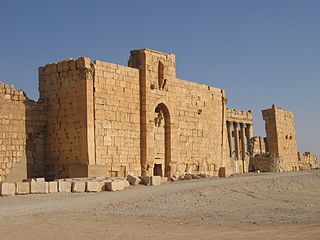| This article needs additional citations for verification. Please help improve this article by adding citations to reliable sources. Unsourced material may be challenged and removed. Find sources: "Bel" mythology – news · newspapers · books · scholar · JSTOR (April 2013) (Learn how and when to remove this message) |
| Part of a series on |
| Ancient Mesopotamian religion |
|---|
 |
|
|
| Primordial beings |
Seven gods who decree
|
| Other major deities |
Minor deities
|
Demigods and heroes
|
| Spirits and monsters |
| Tales |
| Terms |
| Part of the myth series on Religions of the ancient Near East |
| Pre-Islamic Arabian deities |
|---|
| Arabian deities of other Semitic origins |
Bêl (/ˈbeɪl/; from Akkadian: bēlu) is a title signifying 'lord' or 'master' applied to various gods in the Mesopotamian religion of Akkad, Assyria, and Babylonia. The feminine form is Bêlit ('Lady, Mistress') in Akkadian. Bel is represented in Greek as Belos and in Latin as Belus. Belit appears in Greek form as Beltis (Βελτις). Linguistically, Bel is an East Semitic form cognate with the Northwest Semitic Baal with the same meaning.
Bel was especially used for the Babylonian god Marduk in Assyrian and neo-Babylonian personal names or mentioned in inscriptions in a Mesopotamian context. Similarly, Bêlit mostly refers to Marduk's spouse Sarpanit. Marduk's mother, the Sumerian goddess often referred to in the Sumerian language as Ninhursag, Damkina, and Ninmah, was often known as Belit-ili ('Lady of the Gods') in Akkadian.
Other gods called "Lord" were sometimes identified totally or in part with Bel Marduk. The god Malak-bel of Palmyra is an example, attested as a messenger of Bel but existing as a deity separate to Bel/Marduk. Similarly, Zeus Belus mentioned by Sanchuniathon as born to Cronus/El in Peraea is unlikely to be Marduk. Early translators of Akkadian believed that the ideogram for the god called Enlil in Sumerian was to be read as Bel in Akkadian. Current scholarship holds this as incorrect, but Bel is used in referring to Enlil in older translations and discussions.
In Mandaean cosmology, the name for Jupiter is Bil (ࡁࡉࡋ), which is derived from the name Bel.
Bel of Palmyra, Syria
A god named Bel was the chief-god of Palmyra, Syria in pre-Hellenistic times, being worshipped alongside the gods Aglibol and Yarhibol. Originally, he was known as Bol, after the Northwestern Semitic word Ba'al (usually used to refer to the god Hadad), until the cult of Bel-Marduk spread to Palmyra and by 213 BC, Bol was renamed to Bel. The Temple of Bel in Palmrya, Syria was dedicated to this god. The temple has since been destroyed by ISIS.
-
 Bel of Palmyra, Syria, depicted on the far left alongside Ba'alshamin, Yarhibol and Aglibol on a relief from Palmyra
Bel of Palmyra, Syria, depicted on the far left alongside Ba'alshamin, Yarhibol and Aglibol on a relief from Palmyra
-
 Fortified gate of the Temple of Bel in Palmyra, Syria
Fortified gate of the Temple of Bel in Palmyra, Syria
See also
- Ba‘al
- Bel and the Dragon
- Belial
- Belus (disambiguation)
- EN (cuneiform)
- Marduk
- List of Mesopotamian deities
References
- Orr, James (1915). The International Standard Bible Encyclopaedia. Howard-Severance Company. pp. 349–. Retrieved 4 April 2013.
- Bhayro, Siam (10 February 2020). "Cosmology in Mandaean Texts". Hellenistic Astronomy. Brill. pp. 572–579. doi:10.1163/9789004400566_046. ISBN 9789004243361. S2CID 213438712. Retrieved 3 September 2021.
- Rostovtzeff, M. I. (1932). "The Caravan-Gods of Palmyra". The Journal of Roman Studies. 22. Society for the Promotion of Roman Studies: 107–116. doi:10.2307/297093. JSTOR 297093. S2CID 163542083.
- ^ Teixidor, Javier (1979). The Pantheon of Palmyra. Brill Archive. ISBN 9004059873.
- Drijvers, H. J. W. (1980). Cults and Beliefs at Edessa. Brill Archive. ISBN 9004060502.
- Romey, Kristin (26 August 2015). "How Ancient Palmyra, Now in ISIS's Grip, Grew Rich and Powerful". National Geographic News. National Geographic Society. National Geographic Partners, LLC. Retrieved 30 November 2019.
External links
- Bartleby: American Heritage Dictionary: Semitic Roots: bl (Dead link. Archived 15 October 2008 at the Wayback Machine)